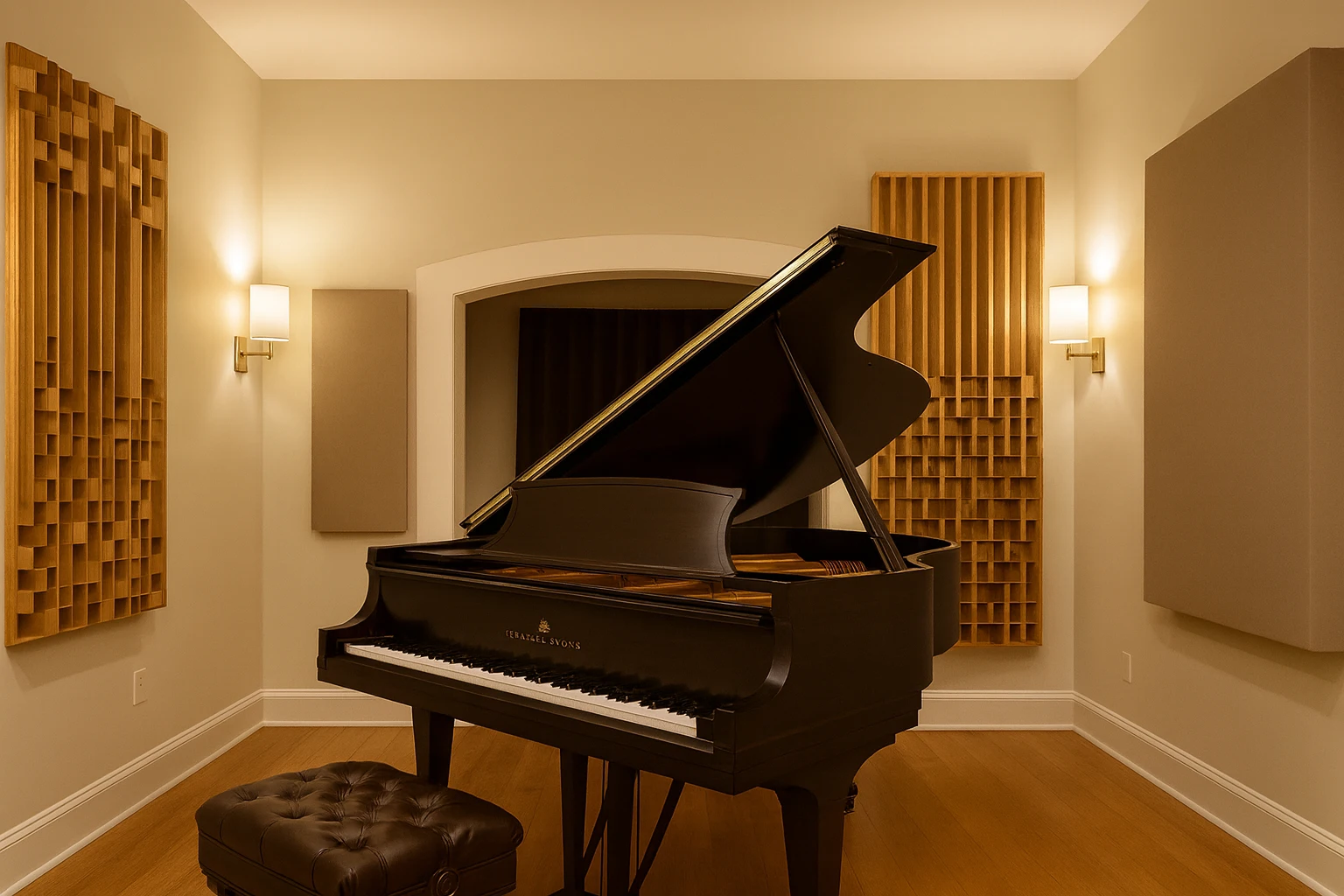Welcome to Angeles Academy of Music, where we make guitar lessons (chord and finger picking) fun and achievable for absolute beginners.
Whether you’re a kid strumming your first guitar or an adult picking up the instrument later in life, our expert instructors guide you through the fundamentals with patience and enthusiasm.
In this article, we’ll dive deep into basic chord theory, common beginner mistakes, right-hand fingerpicking techniques, and even suggest some beginner-friendly fingerstyle songs to get you started on a solid foundation.
Basic Chord Theory and Open Chords
A chord is simply a collection of three or more notes played together. For example, a C major chord stacks the notes C–E–G. Understanding this theory helps you see that open chords (the first chords most beginners learn) are just simple shapes of these note stacks.
Open chords use one or more unfretted (open) strings, and they’re typically found in the first three frets of the guitar. This is why beginner guitarists often start with chords like C, G, D, E, A, Am, Em, and Dm – they involve open strings and are relatively easy to play.
In fact, thousands of popular songs use just three or four open chords, so learning these gives you the freedom to accompany many tunes right away.
Open chords form the foundation of early guitar playing. For example, the open D major chord (shown above) uses open D and high E strings along with fretted notes on the first fret of G and second frets of B and E.
Many beginner fingerpicking songs use such open chords as their basis. Learning to play and smoothly switch between shapes like D, C, G, and A will put a huge library of songs at your fingertips.
At Angeles Academy, we teach these open-position chords first, because they are “easier to play than barre chords, and there are thousands of songs that can be learned and played using just 3 or 4 open chords”. This approach builds finger strength, hand coordination, and calluses — all while playing music you love.
When learning these chords, proper hand positioning is crucial. Beginner guitarists often grip the neck too hard or press with the wrong part of the finger, leading to buzzing or muted notes.
We show students how to place their thumb on the back of the neck (not over the top) and to use the fingertips to press strings with just enough force.
As one of our students, Nina from Los Angeles, discovered: once she relaxed her grip and used her fingers in a curved shape, her chords sounded clear almost overnight.
Remember, training the brain and hands through correct positioning is part of building muscle memory, so reinforce these fundamentals early.
Transitioning Between Chords
A common challenge for beginners is changing chords quickly and cleanly. At first, moving from one shape to another can feel like a puzzle: “Is fingerstyle harder than chords?” you might wonder.
The answer is that fingerstyle (individual note picking) requires more right-hand dexterity than simple strumming, but chord transitions themselves are mostly a left-hand skill.
One helpful tip (backed by our instructors and cognitive research) is to visualize the next chord shape before you move your fingers. For example, when switching from a C to an Am chord, notice that two of the fingers stay on the same string or fret.

Looking at the fretboard and anticipating the chord shape lets your fingers “follow your preconceived path, reducing hesitation or fumbling”. Over time, this mental mapping becomes automatic.
Another trick is to minimize unnecessary movement. A teacher might say: “Lift only the fingers that need to move.” For instance, going from A minor to D major only requires the index finger to slide down a string.
This small shift “is a significant revelation” for newbies because it slashes the number of movements. In practice sessions, we encourage breaking songs down: practice the pair of chords (e.g. G to C) without strumming, slowly at first, then gradually add rhythm.
As one student, Raj, learned: focus on placing one finger at a time (“build each chord from the lowest note upward”) and your transitions will start to feel smooth.
In fact, music psychology tells us that repeated practice builds neural patterns that make complex motions automatic and smooth over time, so persistence with slow, mindful switching pays off.
Common Beginner Mistakes and How to Fix Them
We have seen many beginners face some common hurdles that we will cover. By being aware of these early, you’ll progress faster and avoid frustration.
- Poor Hand Positioning: Beginners tend to grip too hard or place the thumb over the neck, causing buzzing notes.
Always keep your thumb behind the neck (roughly opposite your middle finger) and press with just the fingertip pads. This “light touch” approach avoids fatigue and gives a cleaner tone. Practice slowly and listen; aim for each note to ring clearly. - Tension and Posture: Slouching or tensing up makes finger movements stiff. We coach students to sit up straight, guitar angled slightly upward, and to hold the guitar close to the body.
Use a footstool if needed. Good posture allows longer practice sessions and better control. One Angeleno student remarked that simply adjusting how she sat removed wrist strain and made barre chords (like F major) suddenly manageable. - Relying Too Much on Chord Charts: It’s tempting to sight-read chord charts, but memorizing shapes without understanding them can limit you.
Take the time to learn what makes up a chord (root, third, fifth notes) so that playing by ear and improvising becomes possible. Depending on chord charts may prevent foundational understanding of chords, or how they relate to scales.
We encourage students to sometimes cover the chart and play from memory or by ear – this builds musical intuition and confidence. - Irregular Practice: Many drop the guitar for weeks at a time. Consistency is key – even 10–15 minutes a day is better than one two-hour session per week.
Establish a routine. Learning is really about neuroplasticity: each practice session “rewires” your brain to play chords more automatically.
You can even vary practice (short bursts of chord changes, fingerpicking exercises, sight-reading) to keep your brain engaged and avoid burnout.
By focusing on these fundamentals – proper hand shape, relaxed posture, and smart practice – most beginners see progress in weeks, not years. As one psychology-based guitar learning guide suggests, consistent & efficient practice is the fastest route to making the motions “automatic and reliable” in your brain.
Getting Started with Fingerpicking
Fingerpicking (also called fingerstyle) opens up a whole new expressive world beyond simple strumming. In fingerpicking guitar, you use fingers (and sometimes a thumb pick or fingerpicks) to pluck individual strings, often combining bass notes and melody in one pattern.
Of course, while fingerstyling, you’ll encounter that most of the left-hand shapes are those of chords only.
Beginners should start with simple fingerpicking patterns: for example, using the thumb (p) on the bass strings (E, A, D) while the index (i), middle (m), and ring (a) fingers handle the G, B, and high E strings.
A classic beginner pattern is alternating thumb-on-bass and then successive fingers on the higher strings (known as Travis or bass-thumb rolls).
Right-hand technique is crucial: we teach players to use an “effective finger assignment.” A good rule is – thumb on the 6th, 5th, 4th strings (E, A, D), index on 3rd (G), middle on 2nd (B), ring on 1st (high E). Keep the right hand positioned above the soundhole with a slightly raised wrist so that the fingers approach the strings at about a 90° angle.
This angle gives more leverage and power than a flat pick position. Importantly, only the fingers should move while plucking – the hand, wrist, and arm stay relatively still. (If you notice your wrist or arm swinging, practice with them glued in place!)
This “isolated finger movement” prevents wasted energy and leads to cleaner patterns. Over time, your brain will build the same muscle memory for fingerpicking that it does for chords, making once-difficult patterns feel easy.
Finger picks vs. Bare Fingers
Beginners often wonder whether to use fingerpicks (small plastic or metal picks attached to fingers) or simply natural nails.
Many teachers recommend growing out or shaping your nails on the picking hand to give a clear tone. As one pro explains, a mix of roughly 60% nail and 40% flesh yields a balanced sound.

You can use fingerpicks (thumbpicks or shell-like plastic picks) for extra volume or brightness, especially in genres like country or banjo-style playing. However, many acoustic fingerstyle players simply use their bare fingertips and nails for a warm, natural tone.
We advise beginners to experiment: try a nylon thumbpick or metal fingerpicks and compare, but also try playing with just nails.
Over time, you’ll develop the technique and decide which sound you like. (Remember that nylon-string classical guitars naturally encourage playing without picks, whereas steel-string acoustics often pair well with picks.)
Choosing a Guitar
The type of guitar matters for comfort. Nylon-string (classical) guitars have softer, lower-tension strings that are easier on young fingers.
Many beginners and kids start on a classical guitar for this reason. Steel-string acoustics produce a brighter, louder sound but require more finger pressure to fret notes.
Both can be used for fingerpicking, but if you feel sore fingertips in the first weeks, a nylon-string guitar can help you build up strength slowly. At Angeles Academy, we have both types of guitars available for students; your instructor can advise which fits your style and physical comfort.
Easy Fingerpicking Patterns and Songs
Once your right-hand technique is comfortable, it’s fun to apply fingerpicking to actual songs. Beginners often start with “picking pattern” songs – tunes that use simple repeated finger motions over basic chords. Here are a few classic starter songs recommended by experts:
- “Ain’t No Sunshine” (Bill Withers): This song uses a minor-key bluesy vibe with just three chords. Its guitar part is a simple bass-and-pick pattern that many singer-songwriters use. You only need three fingers of each hand, with the thumb plucking steady bass notes and the fingers walking through the higher strings. It’s a great introduction to alternating bass technique.
- “We’re Going to Be Friends” (White Stripes): A gentle fingerstyle piece built on open chords. The picking involves an octave bass (thumb on low strings) and melodic plucks with a steady rhythm. It teaches control of even octaves alongside chord shapes.
- “Fast Car” (Tracy Chapman): A beloved beginner song that often uses a capo and some simple hammer-ons. It uses a pattern similar to “Ain’t No Sunshine” – steady thumb bass with a melodic fill on top. Practicing it exposes you to moving the capo and adding light embellishments (hammer-ons/slides) over chords.
- “Blackbird” (The Beatles): Although famous, “Blackbird” can be broken down into a two-string fingerpicking pattern using barre chord shapes. Many instructors simplify it so beginners can play a recognizable excerpt. (Our student Alex struggled with “Blackbird” for months until he learned the trick of minimizing finger motion – now he can play the intro cleanly.)
- “Dust in the Wind” (Kansas): Often cited for its iconic fingerstyle pattern (picking pattern alternating bass and arpeggio). While the full song is moderately challenging up to tempo, learning even the intro pattern is excellent practice for syncopation and chord clarity.
The key is to start very simply. Many teachers (and the guided anecdote above) stress: don’t begin with overly complex Travis-picking pieces. As Jon MacLennan advises, focus on songs where the fingerpicking isn’t overwhelming. This way, fingerstyle remains fun, not frustrating.
Q&A: Fingerstyle and Chord Questions
Q: Does fingerstyle use chords?
Absolutely. Fingerstyle guitar is usually built on chord shapes. You still press chords with your fretting hand – the difference is how you play the notes in the chords.

Fingerstyle guitar music often features a variety of left-hand positions that are closely connected to familiar chord shapes, so you will use your chord knowledge extensively.
In fact, one strategy is to strum the chord first, then pick the same strings one at a time, gradually replacing the strum with your finger pattern.
Q: Is fingerstyle harder than chords/strumming?
Generally, yes – fingerstyle (picking individual notes) requires more finger coordination. One of our teachers once said this in a class: “Fingerstyle is more challenging than strumming since it involves plucking individual notes, which demands more precise control and finger coordination.”
That said, beginners can learn it step by step. Start with just thumb-and-index patterns, add one finger at a time, and increase speed slowly.
Over months, your brain will develop the motor patterns so you can fingerpick smoothly — it’s the same process of building muscle memory that made chord transitions automatic.
Q: How do I change chords while fingerpicking?
The same principles for chord changes apply: visualization and efficiency. Mentally preview the next chord shape before you move – this keeps your fingers guided.
Also, find common fingers between chord shapes: often one finger stays in place (or only moves slightly), allowing the rest of your hand to reposition more quickly.
When adding a fingerpicking pattern, consider temporarily stopping your thumb or pattern to focus on the chord shift, then resume picking as the new shape settles.
Practice the chord change and the finger pattern together in slow motion. One helpful exercise: pluck one note of the chord (e.g. the bass) and hold it while you form the next chord, then pick the chord’s notes. This gives you extra time and ensures the bass keeps a beat as you move.
Our instructors often recommend isolating tricky transitions (say G to C) and drilling them until the fingers know the way. Over time, like riding a bike, the motion becomes subconscious.
Q: Can I learn fingerstyle guitar on my own?
Yes, but it’s a challenging skill to self-teach. With online videos, books, and apps, motivated learners can make progress alone. However, a teacher helps correct bad habits before they become ingrained. We have seen that students who learn on their own develop bad playing habits, which may later become difficult or even impossible to undo.
At Angeles Academy, we find that students learn most efficiently with some guidance from an instructor/mentor at the academy – for example, checking your hand angle or finger assignment in real time. Even 30 minutes a week of private lessons can ensure correct and healthy finger positions and postures.
If you do want to try at home, use structured lessons (free tutorials, our guitar course recommendations, or guitar learning apps) and set small goals.
Break practice into micro-skills: one day focus on thumb rolls, another on a two-finger arpeggio over a single chord. Remember the psychology: vary your practice, repeat in chunks, and give your brain rest to consolidate learning.
Also, connect with the local community (search “guitar lessons near me” or “music classes Los Angeles”) to find peer support or online forums. And whenever you get stuck, know that places like the Angeles Academy of Music (a top music academy in Los Angeles) are here to help you overcome roadblocks and stay motivated.
Gear Recommendations: Guitars and Picks
For fingerpicking, a concert or parlor-sized acoustic can be comfortable (the smaller body often projects fingerstyle patterns well).
- Nails (no picks): Many fingerstylists rely on their natural fingernails (with the thumb sometimes using a thumb pick or bare). Properly shaped nails (filed to smooth curves) give a clear, rounded tone. In fact, our advice is to grow your nails slightly – “about a 60/40 ratio of nail to flesh” helps produce a better tone and control.
- Thumbpicks and Fingerpicks: These are small plastic or metal picks that strap onto your fingers. Thumbpicks (like Dunlop’s plastic Star Picks) can give a stronger bass attack. Metal fingerpicks (e.g., National or Shubb picks) produce a very bright, loud tone, which some blues and country players prefer.
Beginners might try nylon fingerpicks first for a gentler sound. The choice is personal: if you want a lot of volume and brightness (for performance or genres like country fingerpicking), picks might help. If you prefer a softer sound (folk, classical), bare fingers/nails usually suffice.
- Strings: Nylon strings are “softer on the fingertips and require less pressure to fret, making them ideal for beginners or those with sensitive fingertips”. Steel strings can sound crisper and project louder, but take more finger strength and can tire new players. A middle ground is using light-gauge steel strings on an acoustic for easier fretting.
Conclusion
Hope this guide helped you with your queries. If you have more, please don’t hesitate to reach out to us.
At Angeles Academy of Music, our friendly instructors specialize in beginner guitar lessons for all ages. If you’re looking for guitar lessons for adults or kids in Los Angeles, we have experienced teachers and proven methods to help you succeed.
From your first open chord to your first fingerpicked song or for any guitar lessons (chord and finger picking), we’ll tailor each lesson to your goals. Contact Angeles Academy of Music today for a free trial lesson or more information.
Keep practicing, stay curious, and enjoy the music you create!
.svg)
.svg)
.svg)
.svg)
.svg)
.svg)





.svg)